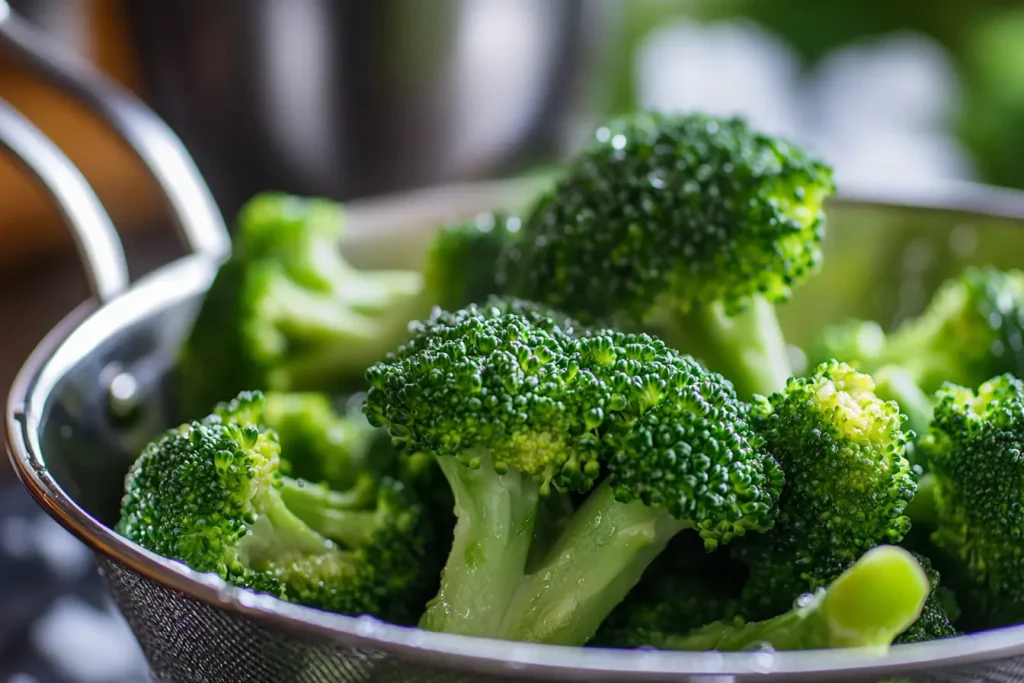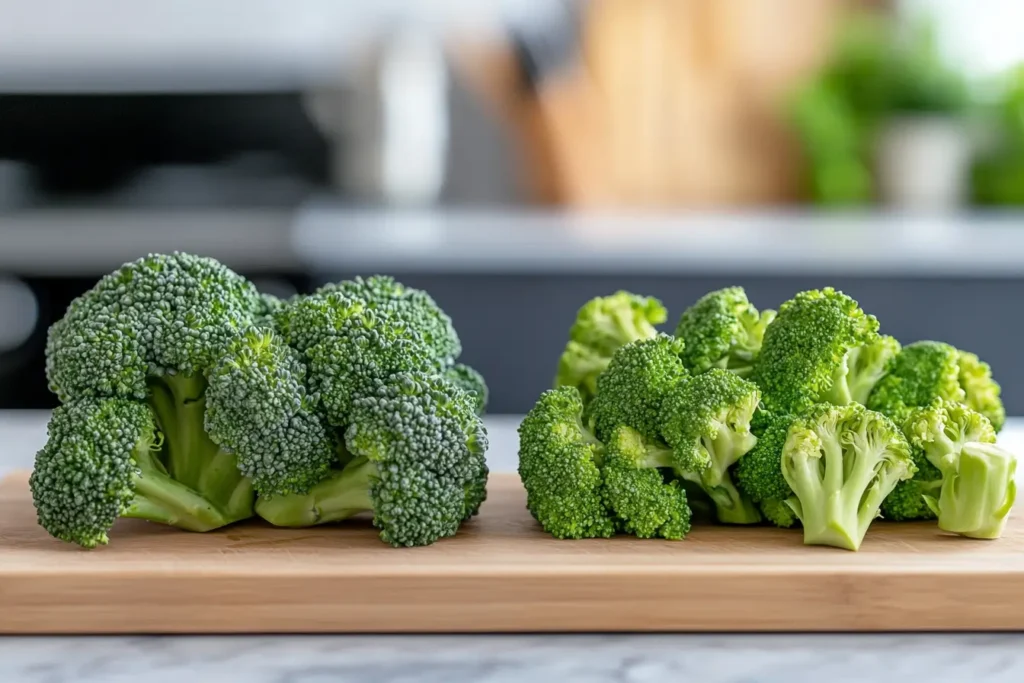Salads are a fantastic way to enjoy fresh, nutrient-rich vegetables, but have you ever wondered why some broccoli salads taste better than others? One key secret lies in blanching. If you’ve ever bitten into raw broccoli and found it too tough or bitter, blanching is the answer.
So, why do you blanch broccoli for salad? Simply put, blanching enhances the texture, color, and taste of broccoli while making it easier to digest. It’s a quick and simple process that transforms broccoli from raw and bitter to crisp and vibrant.
In this article, we’ll cover everything you need to know about blanching broccoli for salads. From the benefits of blanching to step-by-step instructions and alternative preparation methods, you’ll learn how to take your broccoli salad to the next level. Let’s dive in!
Table of Contents
Introduction to Blanching Broccoli for Salad
What Is Blanching?
Blanching is a quick cooking method that involves briefly boiling vegetables and then immediately cooling them in an ice bath. This process helps retain the vegetable’s bright color, crisp texture, and fresh taste. It’s commonly used for preserving vegetables before freezing, but it also plays a crucial role in salad preparation.
For broccoli, blanching is a game-changer. It softens the tough fibers slightly, making the florets tender yet crisp. Plus, it removes any bitterness that raw broccoli may have, making it more palatable for salads.
Why Blanching Is Common in Salad Preparation
Raw broccoli can be tough and difficult to chew, especially when eaten in large pieces. Blanching solves this problem by breaking down the fibrous structure while keeping the broccoli firm and crunchy.
Many chefs and home cooks prefer blanched broccoli in salads because:
- It absorbs dressings and seasonings better.
- It maintains a bright green color, making the salad visually appealing.
- It has a milder, sweeter flavor compared to raw broccoli.
The Importance of Proper Texture in Broccoli Salad
When it comes to salads, texture is everything. A great salad should have a balance of crispness, crunch, and tenderness. If the broccoli is too raw, it can be unpleasantly tough; if it’s overcooked, it becomes mushy.
Blanching strikes the perfect balance, ensuring that the broccoli remains firm but tender. This way, it pairs well with other ingredients like nuts, cheese, or dried fruits, creating a well-rounded, delicious salad.
Now that you understand the basics of blanching, let’s explore its many benefits in the next section!
The Benefits of Blanching Broccoli for Salad

Blanching broccoli before adding it to salads isn’t just about aesthetics—it significantly enhances texture, taste, and digestibility. So, why do you blanch broccoli for salad? Let’s explore the key benefits.
Enhancing Color and Presentation
Raw broccoli can look dull and slightly grayish-green, but blanching transforms it into a vibrant, deep green vegetable. This process locks in the color by stopping enzymatic reactions that cause fading.
A visually appealing salad isn’t just about taste—it’s also about making the ingredients pop. Whether you’re serving a classic broccoli salad with bacon and cheese or a light, vegan version, blanched broccoli elevates the dish’s aesthetic appeal.
Improving Texture – Crisp Yet Tender
Raw broccoli can be too fibrous and tough to chew. However, overcooked broccoli turns mushy, making it less appealing in a salad. Blanching finds the perfect middle ground—softening the broccoli slightly while maintaining a satisfying crunch.
This crisp-yet-tender texture also allows blanched broccoli to hold up well in salads without wilting when mixed with dressing, unlike raw florets, which may become limp over time.
Reducing Bitterness and Enhancing Flavor
Some people avoid raw broccoli because of its slightly bitter taste. That’s because broccoli contains sulfur-containing compounds known as glucosinolates, which give it that sharp, earthy flavor.
Blanching helps to mellow out the bitterness while preserving the natural sweetness of the vegetable. If you’ve ever found raw broccoli overwhelming, this quick process can make it much more enjoyable in a salad.
Making Broccoli Easier to Digest
Raw cruciferous vegetables like broccoli can sometimes cause bloating or digestive discomfort due to their high fiber content. Blanching helps to break down some of the tough fibers, making it gentler on the stomach without compromising its nutritional benefits.
If you love broccoli salads but struggle with digestion, blanching could be the solution you need!
Killing Bacteria and Removing Impurities
Even after washing, raw vegetables can contain dirt, bacteria, or pesticide residues. Blanching provides an extra layer of food safety by exposing broccoli to high heat for a short time, effectively eliminating harmful microbes.
For those who prioritize food safety—especially when preparing salads for gatherings—blanching is a simple yet effective step to keep your dishes clean and fresh.
Now that we’ve covered the many advantages of blanching, let’s move on to the step-by-step process to ensure you do it correctly.
How to Blanch Broccoli Properly

Blanching might sound complicated, but it’s surprisingly easy! Follow these steps to get the best results.
Step 1: Choosing the Right Broccoli for Blanching
Freshness matters! Select broccoli that is deep green, firm, and free of yellowing or soft spots. Older broccoli tends to lose its crunch, making it less ideal for blanching.
For salads, opt for small to medium florets since they’ll hold their shape better after blanching.
Step 2: Preparing the Broccoli (Washing and Cutting)
Before you start blanching, rinse the broccoli thoroughly under running water to remove any dirt or pesticides. Then:
- Cut the florets into bite-sized pieces.
- Trim the stems and peel the outer layer if they’re tough.
- Keep the pieces uniform in size for even blanching.
Step 3: Boiling Water vs. Steaming for Blanching
Boiling is the most common blanching method, but steaming works too. Here’s how they compare:
- Boiling Method: Drop the broccoli into salted boiling water for 1-2 minutes.
- Steaming Method: Place the broccoli in a steaming basket above boiling water for 2-3 minutes.
Boiling is quicker and more effective at reducing bitterness, while steaming retains more nutrients.
Step 4: Ice Bath – The Secret to Keeping Broccoli Crisp
Once blanched, promptly move the broccoli into a bath of ice water. This stops the cooking process and locks in that bright green color and crisp texture.
Without an ice bath, the residual heat continues to cook the broccoli, leading to over-softening.
Step 5: Draining and Drying Before Using in Salad
Once the broccoli has cooled for at least 2 minutes, drain it well. Spread the florets on a paper towel and pat dry. Excess moisture can water down your salad dressing, so drying is an essential step.
Common Mistakes to Avoid While Blanching Broccoli
- Overcooking: Leaving broccoli in boiling water too long results in mushy, flavorless florets. Stick to 1-2 minutes.
- Skipping the Ice Bath: Without it, the broccoli continues cooking and loses its crisp texture.
- Not Drying Properly: Wet broccoli can make your salad watery. Use a salad spinner or paper towels to remove excess moisture.
- Blanching Too Early: Freshly blanched broccoli tastes best. If prepping ahead, store it in an airtight container in the fridge for up to two days.
Now that you know how to blanch broccoli like a pro, let’s explore some alternative ways to prepare broccoli for salads in the next section!
If you want to learn more about preventing watery salads, check out Why Does My Broccoli Salad Get Watery? on First Tasting!
Alternative Methods to Prepare Broccoli for Salad
Blanching isn’t the only way to prepare broccoli for salads. While it enhances color and texture, some people prefer other cooking methods to achieve different flavors and textures. Below are some great alternatives to blanching, depending on your taste preferences and desired salad consistency.
Using Raw Broccoli: Pros and Cons
Some salad lovers enjoy the natural crunch of raw broccoli, but it comes with its own set of advantages and drawbacks.
Pros:
- Retains all nutrients without any loss from cooking.
- Offers a bold, earthy crunch that pairs well with creamy dressings.
- Takes no extra preparation—just wash, chop, and mix!
Cons:
- Can be tough and fibrous, making it harder to chew.
- The natural bitterness may be overpowering for some.
- May lead to digestive issues due to its high fiber content.
If you prefer raw broccoli in your salad, consider chopping it into smaller florets or marinating it in dressing for a few hours to soften the texture.
Steaming vs. Blanching: Which Is Better?
Steaming is another popular method for preparing broccoli, but how does it compare to blanching?
Steaming Benefits:
- Gently softens the broccoli without making it soggy.
- Preserves more nutrients than boiling.
- Produces a mild, slightly sweet flavor.
Blanching Benefits:
- Enhances color and texture quickly.
- Reduces bitterness more effectively.
- Helps kill bacteria and preserve freshness.
If you’re looking for a crisp but tender bite, steaming is an excellent alternative. However, if you want to maintain the bright green color while reducing bitterness, blanching is the better choice.
Roasting Broccoli for a Smoky Flavor
Roasting brings out a rich, caramelized flavor in broccoli that’s perfect for warm or cold salads.
To roast broccoli for salad:
- Preheat your oven to 400°F (200°C).
- Toss broccoli florets with olive oil, salt, and pepper.
- Arrange them on a baking sheet in a single layer.
- Roast for 15-20 minutes, flipping halfway through.
The result? A crispy, slightly charred texture that pairs beautifully with tangy vinaigrettes and nuts.
Marinating Raw Broccoli for Enhanced Taste
If you want to keep your broccoli raw but make it softer and more flavorful, marinating is a great trick.
Here’s how to do it:
- Toss raw florets in a mix of olive oil, lemon juice, and a pinch of salt.
- Let them sit for at least 30 minutes (or overnight for deeper flavor).
- Add them to your salad with other ingredients.
This method helps break down some of the fibrous texture while infusing the broccoli with a fresh, zesty taste.
Want more salad ideas? Check out this Broccoli-Cauliflower Salad Recipe for another delicious variation!
The Best Broccoli Salad Recipes Featuring Blanched Broccoli

Blanched broccoli is the perfect base for a variety of salads. Whether you’re looking for something rich and indulgent or light and fresh, these recipes will satisfy your cravings.
Classic Broccoli Salad with Bacon and Cheese
A tried-and-true favorite, this salad is creamy, crunchy, and slightly sweet.
Ingredients:
- 3 cups blanched broccoli florets
- ½ cup crispy bacon, crumbled
- ½ cup shredded cheddar cheese
- ¼ cup red onion, finely chopped
- ½ cup mayonnaise
- 2 tbsp apple cider vinegar
- 1 tbsp honey
Instructions:
- Whisk together mayonnaise, vinegar, and honey.
- In a bowl, combine blanched broccoli, bacon, cheese, and onion.
- Drizzle the dressing over the salad and mix thoroughly.
- Refrigerate for at least 30 minutes before serving.
Vegan Broccoli Salad with Almonds and Cranberries
Looking for a lighter, plant-based option? This salad has all the crunch and sweetness you need without dairy or bacon.
Ingredients:
- 3 cups blanched broccoli florets
- ½ cup slivered almonds, toasted
- ¼ cup dried cranberries
- ¼ cup chopped red onion
- 2 tbsp olive oil
- 1 tbsp lemon juice
- 1 tbsp maple syrup
Instructions:
- Toast the almonds in a dry pan over medium heat until golden brown.
- Mix the blanched broccoli, cranberries, and onion in a large bowl.
- In a small bowl, whisk together olive oil, lemon juice, and maple syrup.
- Drizzle the dressing over the salad and mix thoroughly.
Asian-Inspired Sesame Broccoli Salad
For a unique twist, this Asian-style broccoli salad is savory, nutty, and packed with umami flavor.
Ingredients:
- 3 cups blanched broccoli florets
- 2 tbsp toasted sesame seeds
- 2 tbsp soy sauce
- 1 tbsp rice vinegar
- 1 tsp sesame oil
- 1 tsp honey
- 1 clove garlic, minced
Instructions:
- In a bowl, whisk together soy sauce, rice vinegar, sesame oil, honey, and garlic.
- Add blanched broccoli and toss well.
- Sprinkle with sesame seeds before serving.
Keto-Friendly Broccoli Salad with Avocado Dressing
A low-carb delight, this salad is rich, creamy, and packed with healthy fats.
Ingredients:
- 3 cups blanched broccoli florets
- 1 ripe avocado
- ¼ cup Greek yogurt
- 1 tbsp lemon juice
- 1 tbsp olive oil
- Salt and pepper to taste
Instructions:
- Mash the avocado and mix it with Greek yogurt, lemon juice, olive oil, salt, and pepper.
- Toss with the blanched broccoli until well-coated.
- Serve immediately for a fresh, creamy salad.
FAQs
Blanching broccoli is a simple but effective technique that enhances both the taste and texture of salads. However, many people still have questions about this method. Below, we’ll answer some of the most common questions about blanching broccoli and related topics.
What Is the Mix Between Broccoli and Cauliflower?
The mix between broccoli and cauliflower is commonly known as broccoflower. This hybrid vegetable combines the best qualities of both—the mild taste of cauliflower and the slight crunch of broccoli.
Why Does My Broccoli Salad Get Watery?
A watery broccoli salad is usually caused by excess moisture from the vegetables or dressing. Here’s how to prevent this issue:
- Dry the broccoli thoroughly after blanching—use a paper towel or salad spinner.
- Avoid adding too much dressing in advance, as salt and vinegar can draw out moisture.
- Use a creamy dressing rather than a watery vinaigrette if storing overnight.
What Is the Healthiest Way to Eat Broccoli and Cauliflower?
The healthiest way to eat broccoli and cauliflower depends on your nutritional goals. Here are a few methods:
- Steamed: Preserves the most nutrients while keeping the vegetables soft but not mushy.
- Blanched: Reduces bitterness and bacteria while keeping the crunch.
- Raw: Retains all nutrients but can be harder to digest.
Why Do You Blanch Broccoli for Salad?
Blanching broccoli for salad is a game-changer because it improves color, texture, and taste while making it easier to digest. Unlike raw broccoli, which can be tough and bitter, blanched broccoli is tender yet crisp.
Additionally, blanching helps:
- Preserve freshness by killing bacteria.
- Improve nutrient absorption, making it more digestible.
- Enhance presentation, giving it a vibrant green color.
If you’ve ever wondered why do you blanch broccoli for salad?, now you have all the reasons to try it in your next dish!
Conclusion
Blanching broccoli is a quick and simple technique that transforms an ordinary salad into something vibrant, delicious, and easy to eat. It enhances color, softens texture without making it mushy, and eliminates bitterness—all while preserving nutrients.
Now that you know why do you blanch broccoli for salad?, you can experiment with different salad recipes and preparation methods. Whether you prefer classic broccoli salad with bacon, a light vegan version, or an Asian-inspired sesame twist, blanched broccoli is the perfect base for a refreshing and nutritious dish.
So, next time you’re making a salad, try blanching your broccoli—it’s a small step that makes a big difference!
Dernière mise à jour : 31 January 2025

